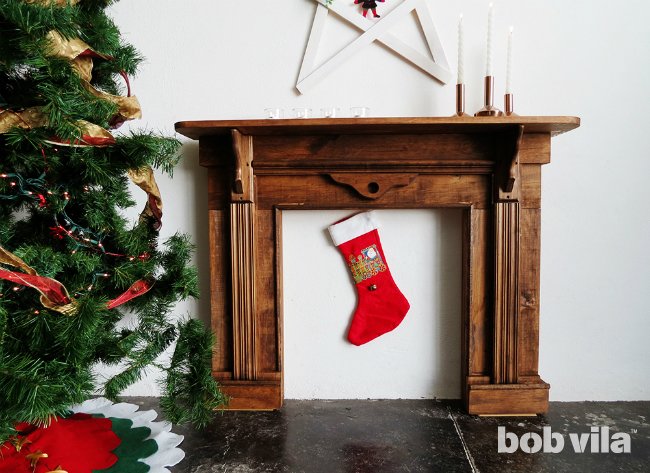We may earn revenue from the products available on this page and participate in affiliate programs. Learn More ›
Even if it’s not operational, a fireplace somehow still makes a space feel cozy—and ups its “architectural charm” factor considerably. If you live in an apartment or modern abode without a wood-burning or electric fireplace to warm you up, you’re not out of luck altogether. Building a faux fireplace out of wood will inspire holiday cheer and provide just the spot to hang your stockings.
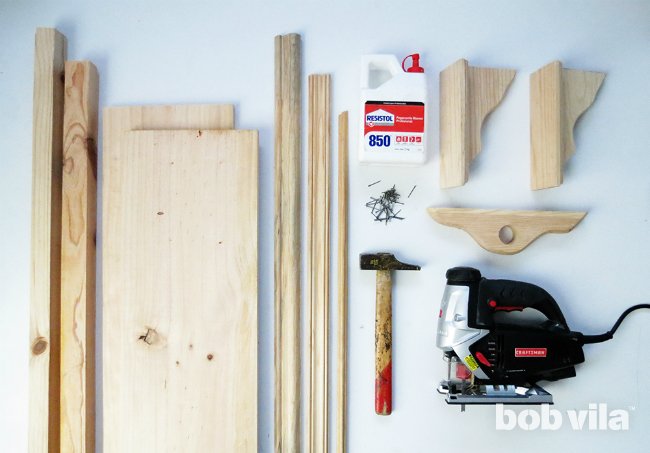
Tools & Materials
Bobvila.com may earn a commission from purchases made through these links.
- Tape measure
- Jigsaw
- Sand paper
- Sanding block
- Palm sander
- Drill
- Wood clamps
- ½-inch-wide wood molding
- 2-inch-wide flexible molding
- 2½-inch-wide wood molding
- Miter box and handsaw
- Paint brush
- (2) 1-inch by 10-inch by 8-foot boards
- (2) 2-inch by 2-inch by 8-foot furring strips
- Wood glue
- (34) 2-inch screws
- (2) 1-inch by 4-inch by 8-foot boards
- (2) 6-inch-deep shelf brackets
- Wooden closet rod support or other small, wooden decorative element (optional)
- Wood stain or paint
- Varnish
- (2) corner brace plates
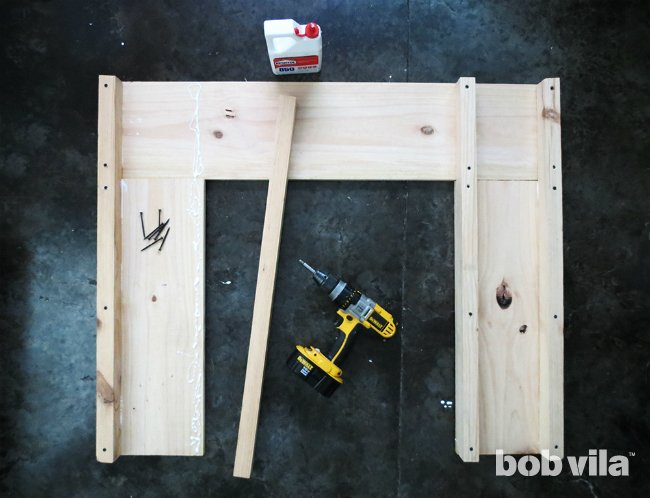
How to Build a DIY Faux Fireplace
Crafty DIYers with basic carpentry skills and tools can put a fireplace together in a weekend. (It won’t take you all weekend to build it, but the wood glue, stain, and varnish need time to dry.) By next weekend, you’ll be cozied up with a cup of coffee or a glass of wine, wondering how you ever did without your new architectural accent.
Step 1: Cut the wood to the required lengths.
Begin building the fireplace structure with one 1×10 and the 2x2s. From them, you’ll need to cut the following:
– One 43-inch piece from one of the 1-inch by 10-inch by 8-foot boards
– Two 26-inch pieces from the other 1-inch by 10-inch by 8-foot board
– Four 35½-inch pieces from the 2-inch by 2-inch furring strips
The 1×10 boards will make up the front surface of your faux fireplace, while the 2x2s connect to the back to add depth to the structure.
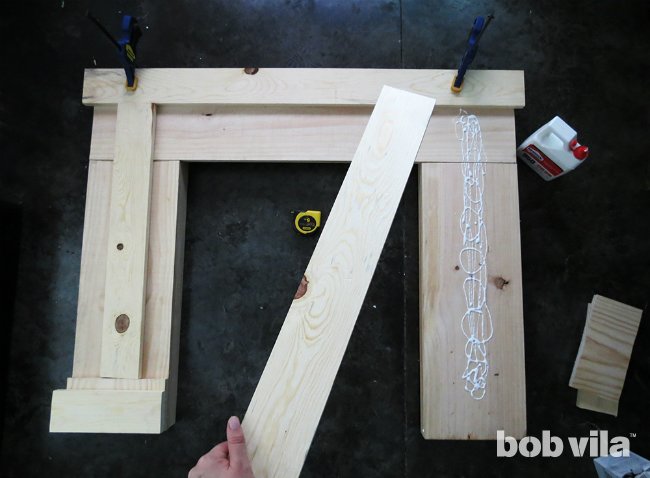
Step 2: Sand and construct the faux-fireplace structure.
Sand all the edges on your fresh cuts using sandpaper, a sanding block, or a palm sander. Lay the 43-inch board on the floor and beneath it, at each end, place the 26-inch pieces perpendicular to the 43-inch piece to form a U-shape. Apply wood glue to the edges where the boards meet. Then, lay the four 2×2 furring strips along the structure vertically so that they span the “U” top to bottom, one along each edge of the vertical 1×10 boards. Pre-drill holes, and use five 2-inch screws to fasten the 2×2 furring strips vertically so that they attach at the top and sides of the U. The side with the furring strips is the back of the fireplace.
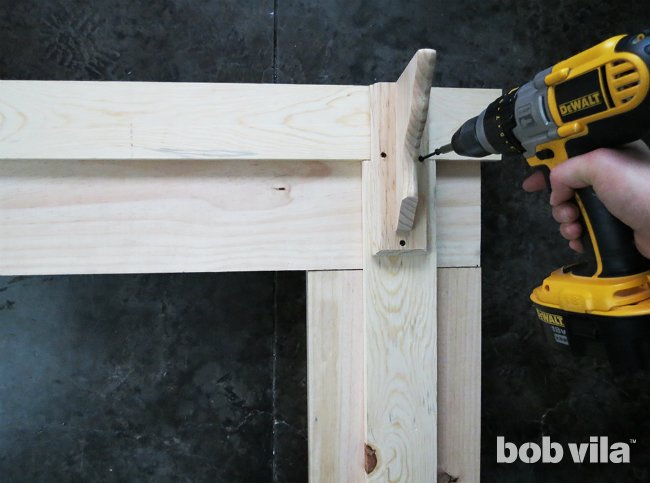
Step 3: Attach an ornamental front.
From the 1×4 boards, cut two 27-inch pieces and one 43-inch piece. Sand the edges to remove splinters before proceeding. Turn the wood structure over so that its front is now facing up. Now it’s time to add some ornamentation to your fireplace. The first cut, 43 inches long, will be glued horizontally, aligned with the top edge of the fireplace. Use a tape measure to center the two 27-inch pieces on each 1×10 so there’s about 3¼ inches of space on each side of the 1×10. The idea is that these 1-inch by 4-inch pieces hold the top and sides of the fireplace together. You can use clamps here to hold the pieces firmly together while the wood glue cures.
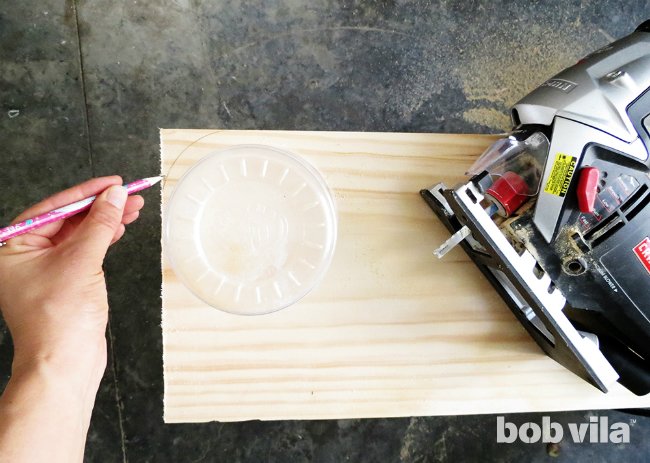
Step 4: Secure the feet.
Add volume at the base of the fireplace by giving it feet that extend slightly. Cut two 5-inch pieces from the remaining 1×10 board and two 9½-inch pieces from the 1×4 board. Stack one 9½-inch by 3½-inch piece atop a 9½-inch-by-5-inch piece so that their longer sides align, then glue. Repeat with the remaining cuts. Place a stack to the bottom of each side of the faux fireplace, at the open ends of the 27-inch pieces. Align the mantel’s feet so that no wood extends past the base of the faux fireplace—it needs to be a flat surface in order to stand up later on—then glue and clamp each piece down.
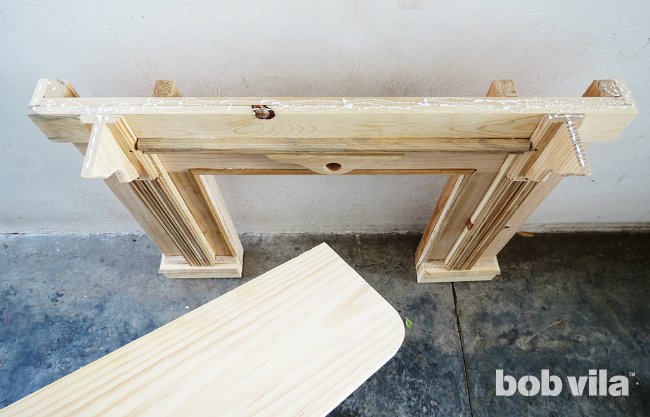
Step 5: Secure the brackets.
To support the board that will be the top mantel of your faux fireplace, fasten a 6-inch-deep wooden shelf bracket onto each side of the fireplace with glue and screws. We centered ours at the very top of the vertical 1×4s.
Note: It’s important to choose brackets that don’t extend out more than 6 inches; otherwise you will not be able to adequately cover them with the mantel in a later step.
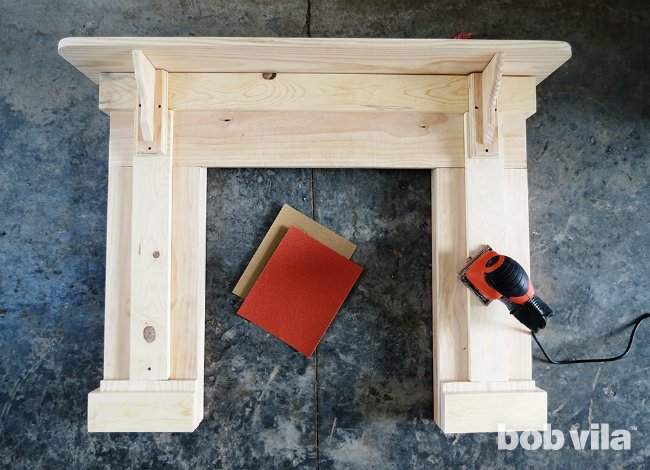
Step 6: Cut the mantelpiece.
Cut a 48-inch length of 1×10 for the top. To complement the curves in the shelf brackets, we gave our mantel top a nicer edge by rounding two corners of the board. Grab a round container (like a cream cheese or butter container), then place it at the top left corner and trace its circumference using a pencil. Use a jigsaw to cut along the quadrant of the circle closest to the corner. Erase the remaining three-quarters of the circle, and repeat at the top right corner.
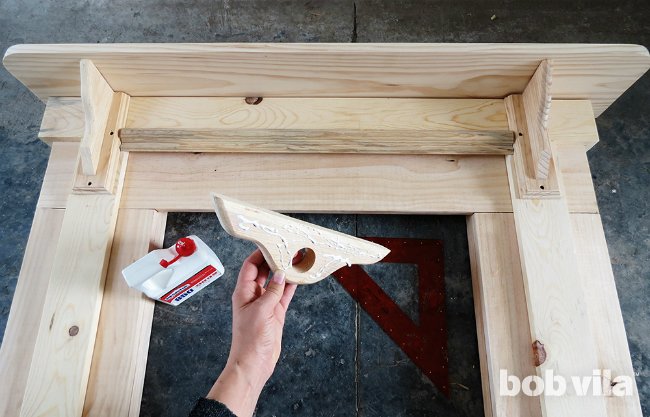
Step 7: Secure the mantelpiece.
With the rounded corners facing outward, center the mantel over the top of the faux fireplace with a 2½-inch overhang on either side. Glue it to the top of the structure, and hold it with clamps while the glue dries.
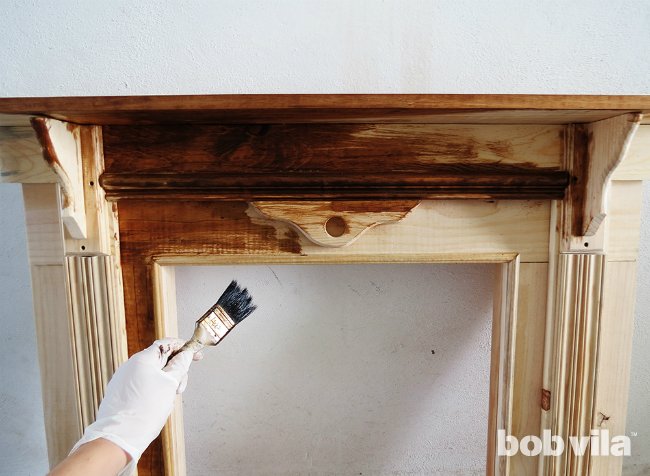
Step 8: Sand any remaining rough surfaces.
Sand the near-finished fireplace. Start with 100-grit paper, and repeat with 150-grit.
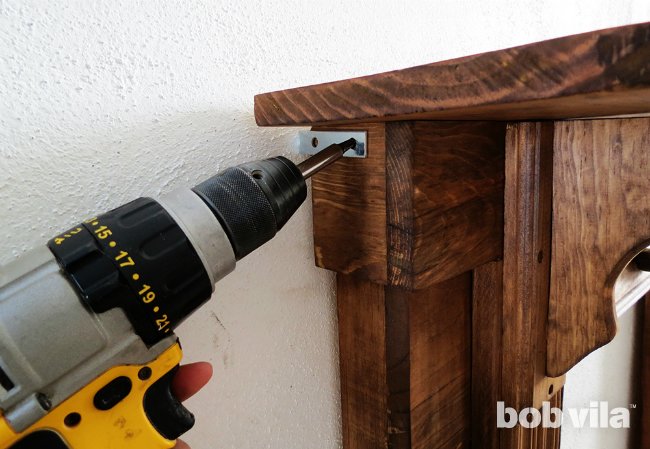
Step 9: Use wood molding for that finishing touch.
Inject even more personality into your project by adding some wood molding along the fireplace opening and atop the 1x4s.
For the fireplace opening, cut three pieces of ½-inch-wide wood molding: two 27½-inch lengths and one 25-inch length. Using a miter box, cut the tops of the 27½-inch pieces to have mirroring 45-degree cuts; proceed to cut the ends of the 25-inch piece at 45-degree angles, each pointing away from the other. The 25-inch length should now fit with the 27½-inch lengths to make a three-sided frame.
For the sides, the exact length of 2-inch-wide flexible molding you’ll need to cover the 1x4s ultimately depends on the size of your chosen shelf brackets. Measure the vertical 1x4s’ exposed surface—from the bottom of the shelf brackets to the top of the mantel feet—and cut four identical pieces that length. Glue two pieces of the flexible molding side by side on each.
As a finishing touch, we glued a 30-inch length of 2½-inch-wide molding beneath the horizontal 1×4 and a wooden closet rod support in the very center. Hold each wooden piece with a clamp while the glue dries.
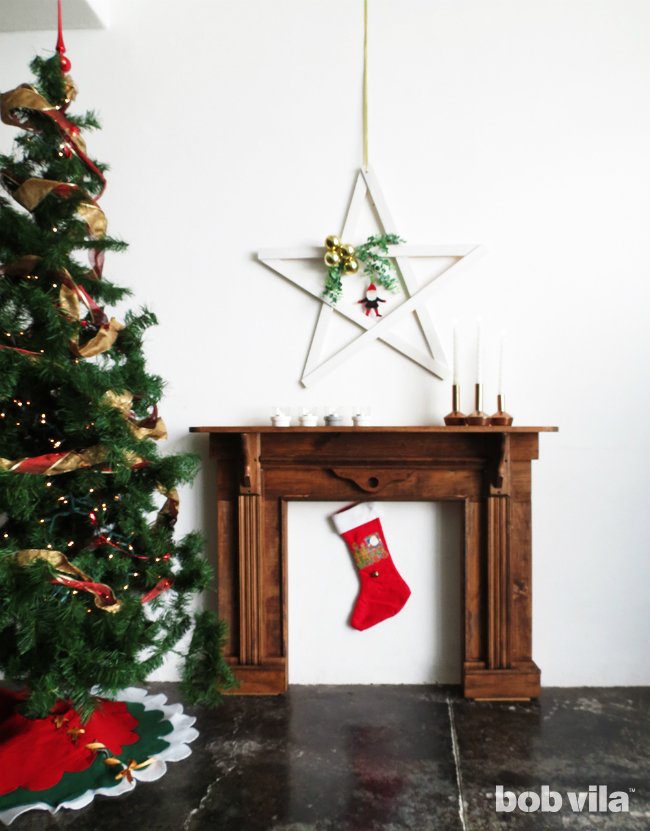
Step 10: Give the faux fireplace a final sanding.
Once all the glue holding the molding has dried, you may want to give it one last sanding to remove any leftover glue. Wipe away the dust with a wet cloth, and paint or stain your fireplace in the hue of your choice, using two coats for best results. (See more details below under “Stain and Paint Colors.”) After you’ve allowed the stain to dry, top it with a coat of varnish to protect the wood.
Step 11: Secure the fireplace.
Now that your faux fireplace is built, move it into the living room. It doesn’t need to find a permanent home on any one wall, but it is best to fasten it so that it won’t topple when you place objects on its mantel. Lean the fireplace wherever you intend to place it, and slide a metal corner brace around one edge just beneath the mantel top, where it’ll be barely visible. Lift the fireplace and screw half of the brace into the wall. Lean the fireplace one more time against the wall so that you can determine where to affix the second metal corner brace. Once both are in the wall, simply screw the exposed ends into the sides of the fireplace.
Step 12: Enjoy!
All that’s left to do is to fill your new faux fireplace with candles or string lights to mimic the cozy glow of lit kindling.
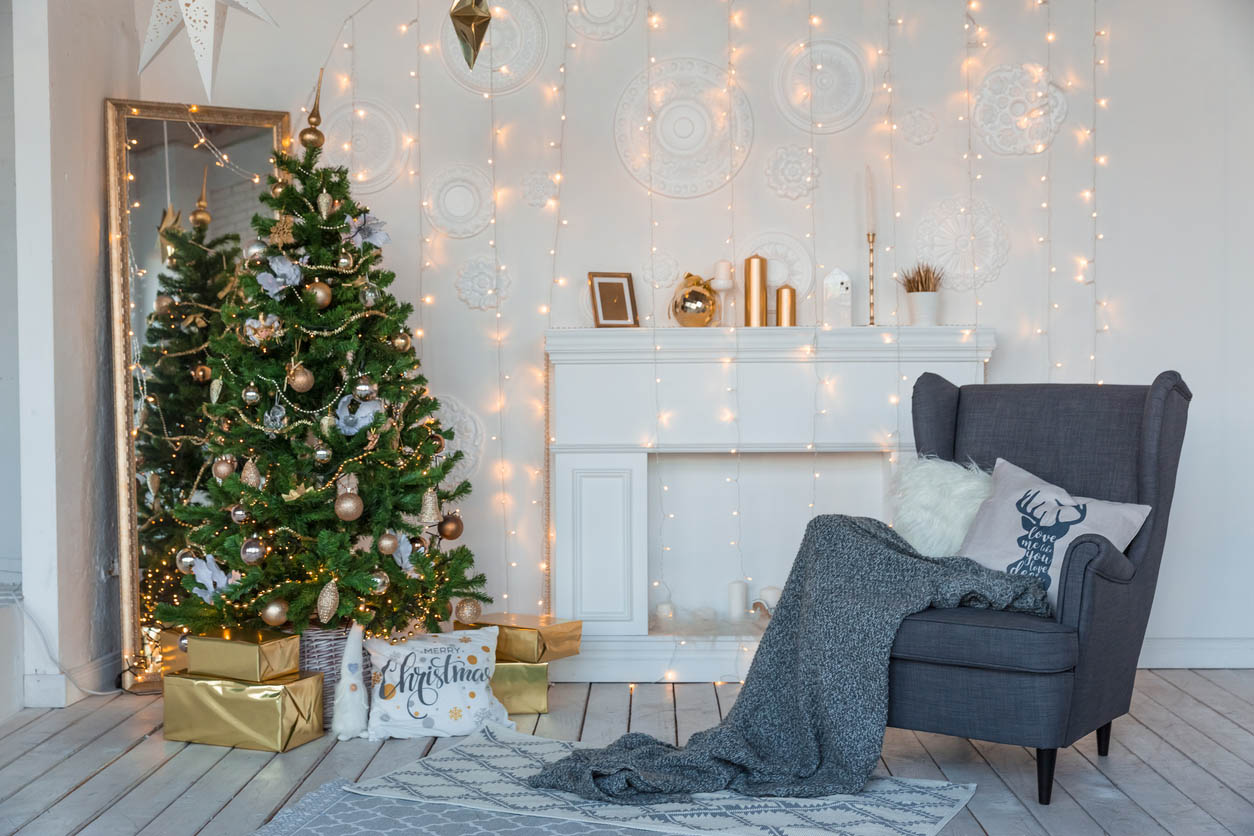
Faux Fireplace Decorative Ideas
Once your faux fireplace is in place, it’s time to customize it. Deck out your new architectural feature with knickknacks for the mantel, and additions to the firebox that suit your personality and your home’s decor.
Stain and Paint Colors
The color you stain or paint the fireplace’s wood makes a huge impact on your space. The first question to ask yourself is whether you want the fireplace to look like it’s been a part of your home all along, or whether you see it as more of a loud-and-proud statement piece. Here are some hue options worth considering:
- Painting your faux fireplace white is a safe choice. It will complement a variety of home styles, from cottagey Cape Cods to minimalist lofts. (A shade we particularly like is Benjamin Moore’s warm Snowfall White.) You can’t go wrong with a fireplace that’s painted in a white latex semi-gloss paint. What’s not to like?
- Does your Prairie-influenced home have gorgeous warm brown trim and built-ins? Is the faux fireplace you built in a room that is wood paneled? In cases like these, staining the fireplace is the way to go. Choose a hue that complements the wood trim and features that are already in the room. We like SamaN’s water-based wood stain in a shade like Brandy or Amaretto. (Don’t forget to varnish the stain once it’s dry.)
- Painting a faux fireplace dark gray or black keeps the vibe neutral, but it can create a stunning contrast in an otherwise light-colored room. Imagine Farrow & Ball’s deep gray Down Pipe, for example, in a living room with a light blue sectional sofa and a glass-top coffee table. Yes, please.
- If you’re looking for a paint hue that guests won’t soon forget, consider a vibrant aqua like Sherwin-Williams’ Cruising or Farrow & Ball’s stunning orange Charlotte’s Locks.
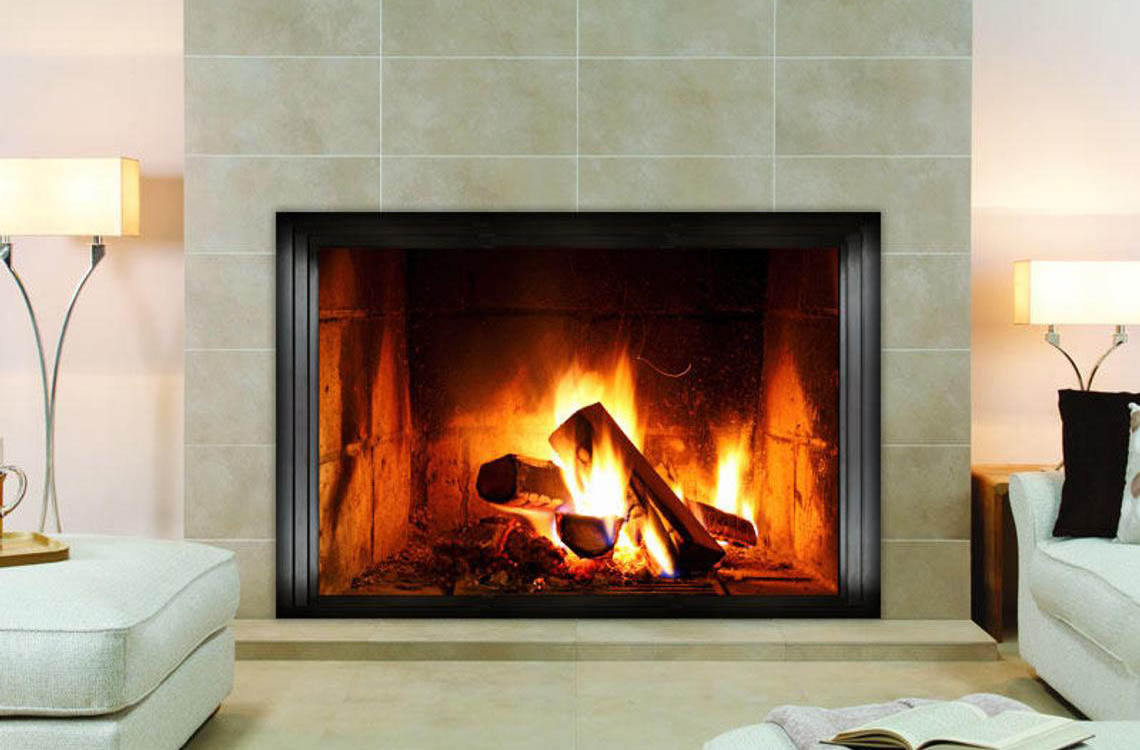
Firebox Fillers
Though there’s no flame or flue inside your faux-fireplace’s firebox, it doesn’t mean that you are stuck looking at the bare wall underneath. Draw the eye to that space with wallpaper, art, or decorative objects that fit your interests and lifestyle.
- A roaring fire decal will make visitors do a double-take. Is it a real fire, or a fake?
- Prop a favorite framed photograph, poster, or artwork inside—and stick an LED light on the underside of the mantel to spotlight it.
- Simulate the flow of a fireplace by situating a candle holder topped with a set of battery-powered, remote-controlled LED candles inside. It’s instant mood lighting, without having to stack firewood or strike a match.
Mantelpiece Decorations
A fireplace mantel is a place of pride, where you display your favorite treasures for visitors to see. It’s common to display heirloom family photos, trinkets, or books on the mantel, but if you don’t have items like these—or if sentiment isn’t your speed—there are other options.
- Bring the outdoors inside with a faux garland and pine cones. These woodsy accents aren’t just for the holiday season, either—they are right at home with rustic or farmhouse-style decor.
- What are just for the holiday season: decorative Christmas stocking holders.
- Candles—either real wax candles or battery-operated versions—are classic mantel companions.
- A mantel is a great place to show off a collection, and the more fun and offbeat the collection is, the better. Show off your treasured ceramic frogs, Star Wars action figures, or jar full of casino chips for your visitors to see. A collection is a great conversation starter, too!
- Finally, don’t limit your decor to the mantel. Consider dressing up your faux fireplace with other decorative additions, like fireplace screens and surrounds.
Ama is a DIY addict and the creative mind behind the Ohoh deco blog. She likes home decor, lighting, and furniture projects that may involve painting, sewing, drilling…no matter the technique! Whatever she has on hand is inspiration to create, and fodder for her serious addiction to upcycling.
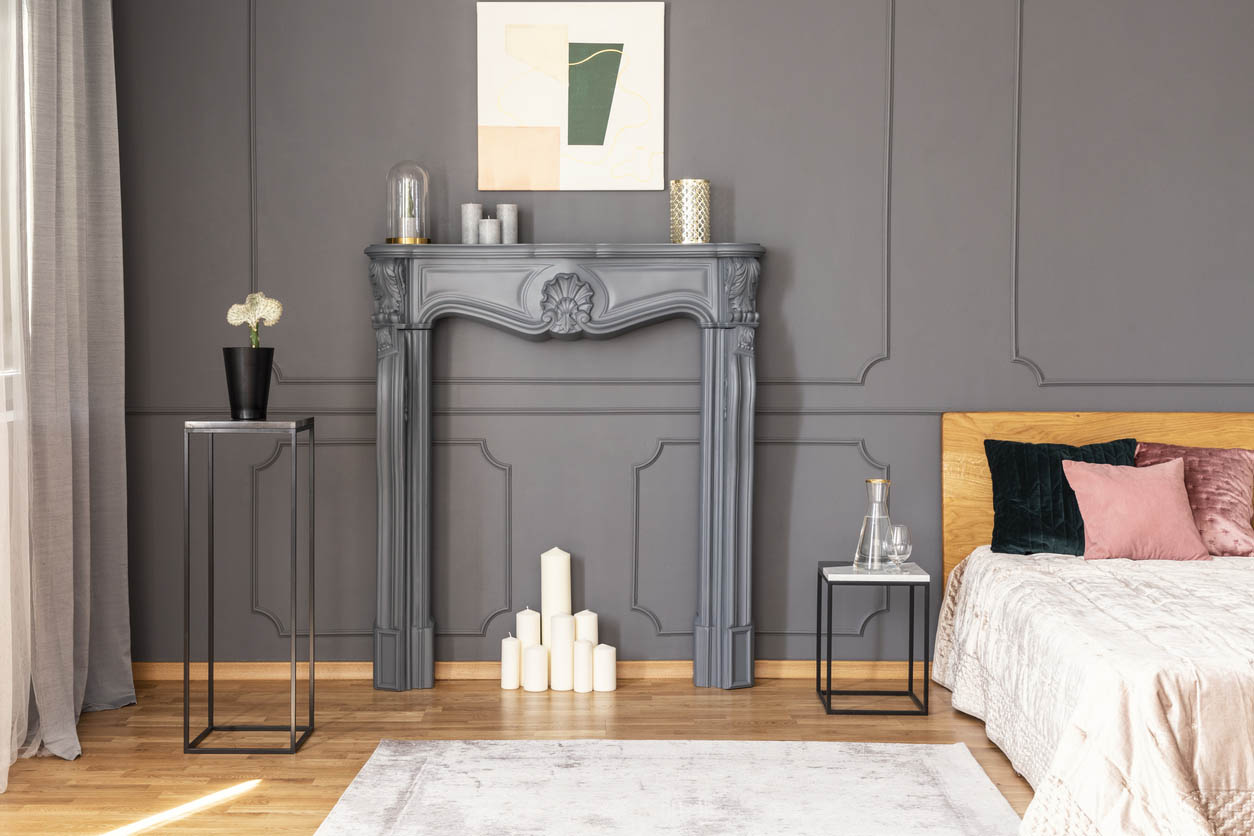
FAQs About How to Build a Fake Fireplace
Q. Can you put a fireplace in a house that doesn’t have one?
You can install a fireplace in a home that doesn’t already have one, but certain kinds of fireplaces will be easier than others to add after the home is already built. Masonry fireplaces are challenging to install after the fact; zero-clearance fireplaces are easier.
Q. Does a fireplace add value to a home?
Fireplaces might add some value, but not much—$500 to $5,000, depending on the property. If your home has a fireplace, don’t get rid of it, but don’t go out of your way to build one hoping to get a better selling price.
Q. Can you install a fireplace without a chimney?
Wood-burning fireplaces require chimneys—smoke and gases have to have a path out of your living space. Ventless gas fireplaces, on the other hand, don’t require chimneys.
Q. How expensive is it to put in a fireplace?
The cost to install a fireplace varies based on the type of fireplace installed. According to HomeAdvisor, the average national cost to install a wood-burning fireplace ranges from $881 to $3,762. In general, electric fireplaces are less expensive to install than their wood-burning or gas counterparts.
